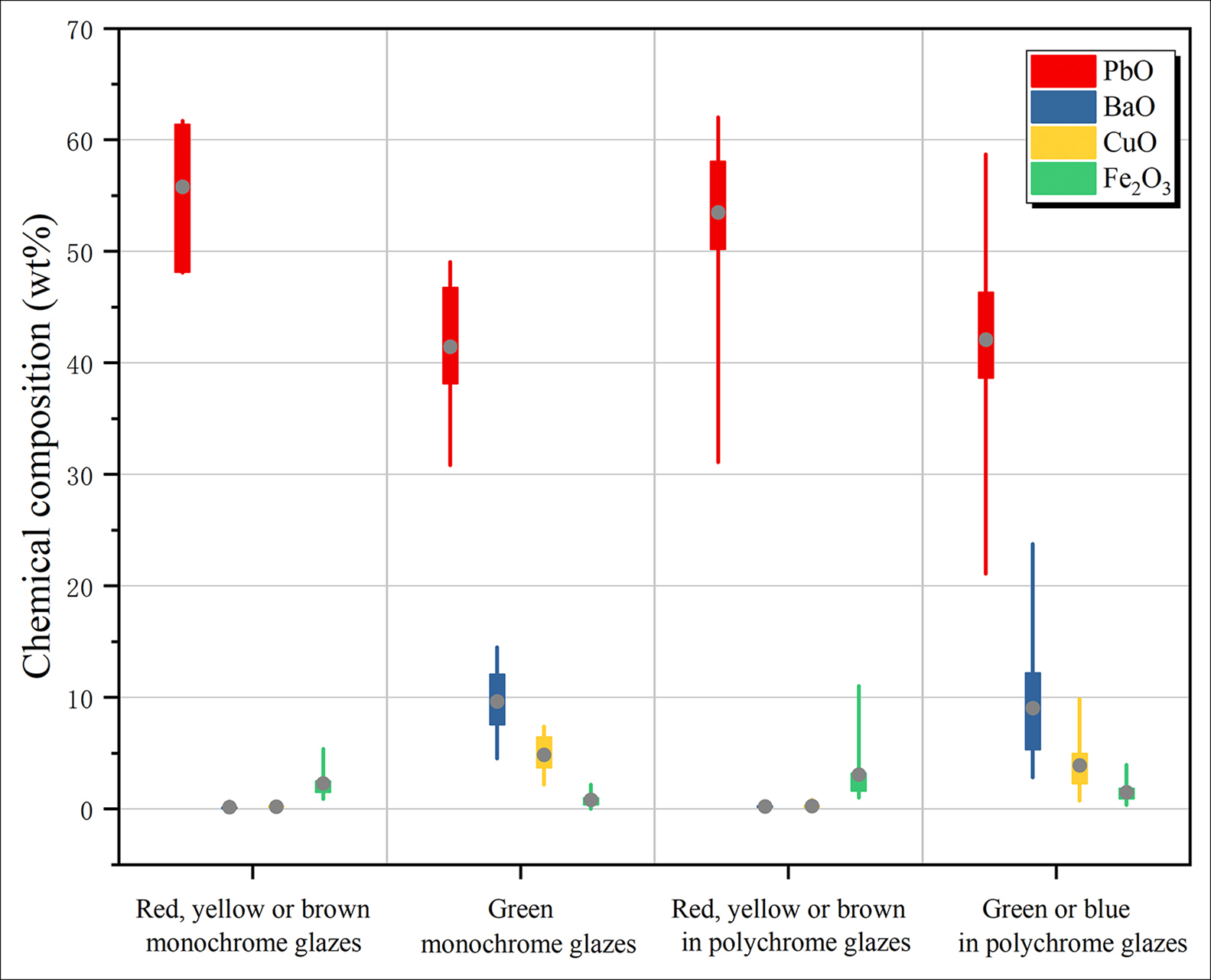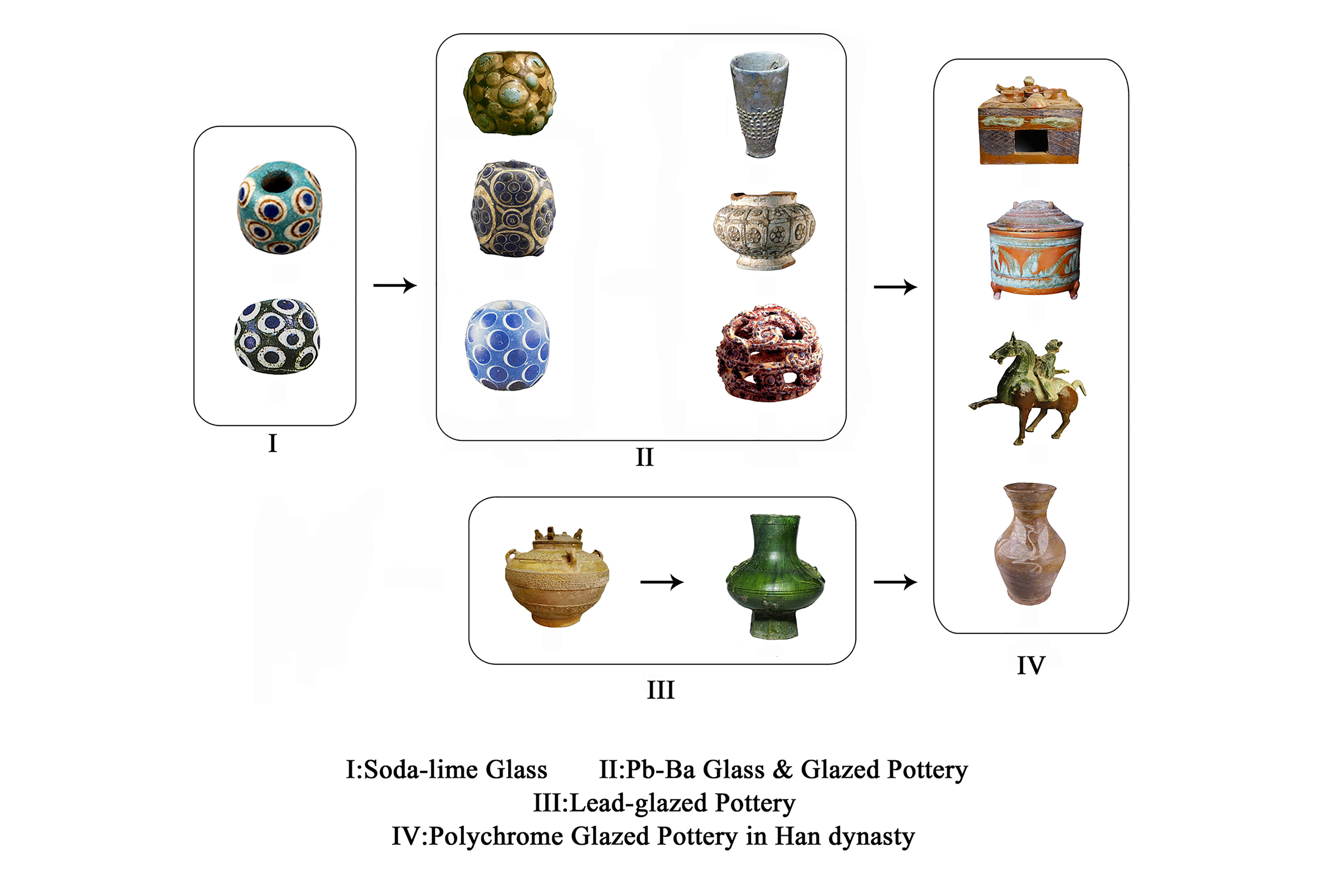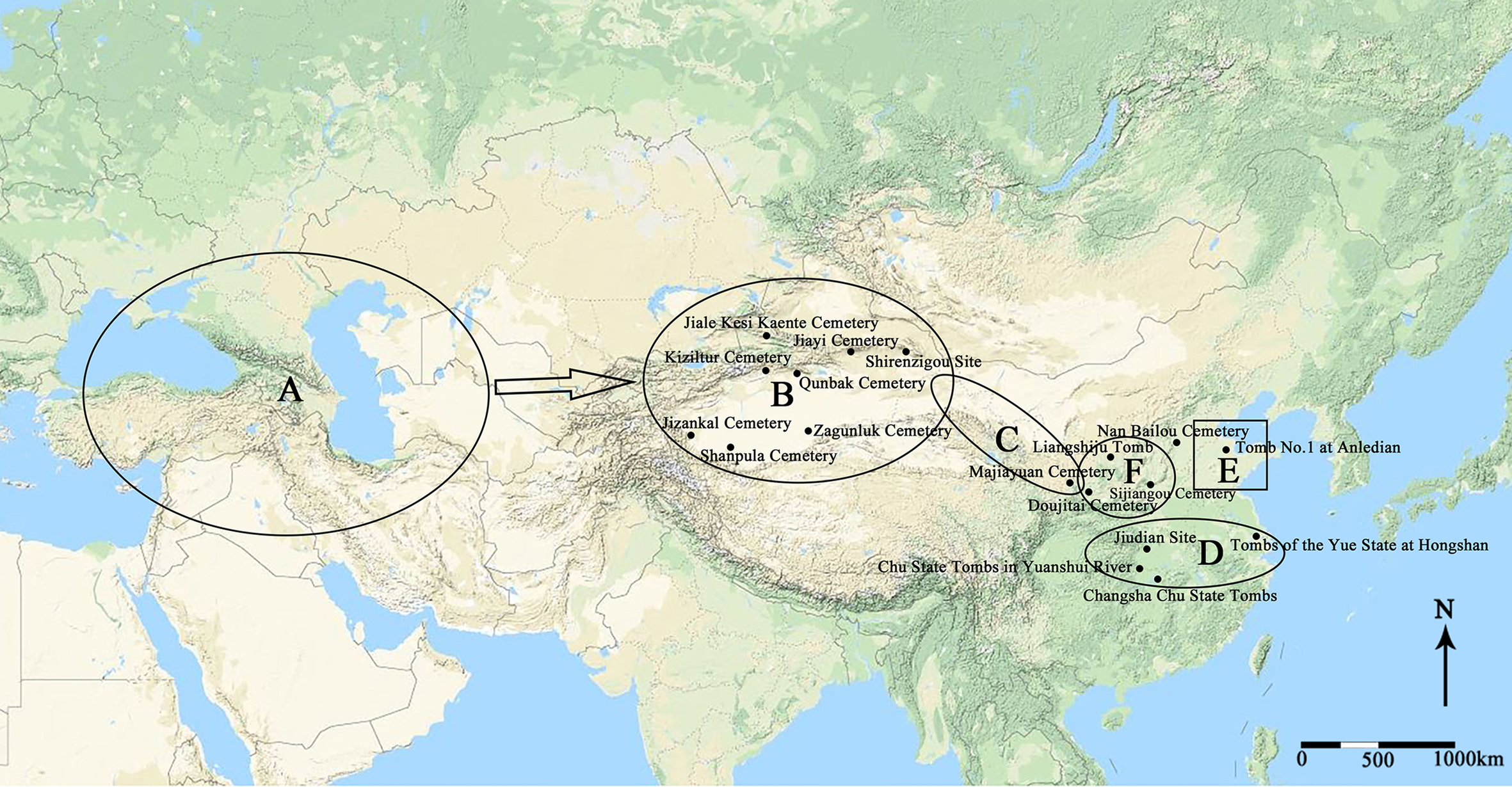Introduction
Chinese ceramics are famous for their high-fire glaze. Produced by firing at high temperatures, this glaze was used in the proto-celadon ceramics of the Shang Dynasty (1600–1046 BC). The low-fire lead glaze technique began more than 1000 years later. This article reports on the analysis of newly discovered low-fire glazed pottery vessels, and argues that the two lead-glaze types—monochrome and polychrome glazes—were not only different varieties of decoration, but also followed different recipes and represent separate technological traditions. This study extends our understanding of the origins of Chinese low-fire polychrome glazed pottery.
Early Chinese low-fire, lead-glazed pottery
Chinese low-fire, lead-glazed pottery originated in the Warring States period (475–221 BC) (Lang & Cui Reference Lang and Cui2017) and flourished during the Han Dynasty (202 BC–AD 220). Most examples were found in Chang'an, Luoyang and adjacent areas (Chen Reference Chen2005). Two types of lead-glazed pottery have been identified: monochrome- and polychrome-glazed ceramics (Wood Reference Wood1999; Chen Reference Chen2005; Hsieh Reference Hsieh2014; Wang Reference Wang2018). Polychrome lead-glazed pottery from the Warring States period to the Han Dynasty in China has stimulated much archaeological interest (Umehara Reference Umehara1954; Fontein Reference Fontein1980; Wood Reference Wood1999; Hsieh Reference Hsieh2014; Dong et al. Reference Dong, Gan, Xia, Li, Liu, Gu, Gan, Li and Henderson2016). The current study analysed 50 newly discovered low-fire glazed Han Dynasty vessels excavated from Yan'an, Shaanxi. The aim was to explore the origins of polychrome lead-barium glazed pottery, and to consider the formation process of the Han Dynasty low-fire polychrome glazed pottery.
Analysis
The samples were tested using electron probe microanalysis and portable X-ray fluorescence. These samples included seven pieces of red, yellow or brown monochrome glazed pottery (Figure 1: 6), nine pieces of green monochrome glazed pottery (Figure 1: 7 & 27) and 34 pieces of polychrome glazed pottery (Figure 1: 1–5, 8–26 & 28–30). The results show that red, yellow and brown glazes are made from lead-silica, and the green and blue glazes are barium-lead-silica (Figure 2).

Figure 1. Han glazed pottery excavated from Yan'an, Shaanxi: 1–8) Hu; 9–11) Ding; 12–15) Zao; 16–20) Cang; 21) Fang; 22) Zun; 23) Guan; 24) flattened Hu; 25) Boshan incense burner; 26) incense burner; 27) Pan; 28) Xiao Hu; 29) duck-shaped Hu; 30) pig-shaped glazed pottery (figure by Tianyi Wang).

Figure 2. Graph showing the chemical composition of coloured glazes (figure by Yulai Chen).
Previous research has shown that most Chinese low-fire glazed ceramics were lead-glazed, with lead-barium glaze being far less common. Almost all monochrome ceramics were lead-glazed, and there are only two known exceptions: the lead-barium glazed specimens housed at London's Victoria and Albert Museum (Wood et al. Reference Wood, Watt, Kerr, Brodrick, Darrah, Li and Chen1992; Wood Reference Wood1999). Archaeological excavations since the late twentieth century have revealed a particular type of polychrome lead-glazed pottery in Yan'an, Baoji and Jiyuan (Wang Reference Wang2018). Our research has also discovered this lead-barium glaze on Han Dynasty ceramics from northern Shaanxi. In terms of chemical composition, the lead-barium glaze is an extraordinary and previously unknown type, and demonstrates a special stage of glazing technology.
Our analysis suggests that the Chinese purple (BaCuSi2O6) and Chinese blue (BaCuSi4O10) on the glazed pottery were directly synthesised during the firing process. The manufacturing technology of ancient barium-copper-silicate pigments (BaCuSi2O6 and BaCuSi4O10) is closely related to that of lead-barium glass (Liu et al. Reference Liu, Mehta, Tamura, Pickard, Rong, Zhou and Pianetta2007; Zhang Reference Zhang2011; Li et al. Reference Li, Yang, Li, Dong, Zhao and Lui2015), suggesting a close relationship between lead-barium glass and polychrome glazes.
Cultural hybridity and integrated technology
Two different types of low-fire glazed pottery existed in the Warring States and Han Dynasty; they differed in their aesthetic form and in glazing technology. The first type is the monochrome lead-glazed pottery. Among the three earliest lead-glazed ceramics known so far, two were unearthed from tomb 1 at Anledian in Zibo (Lang & Cui Reference Lang and Cui2017) (Figure 3: 9), and one is held in the Nelson-Atkins Museum of Art in Kansas City (Umehara Reference Umehara1954). All are imitations of bronze lei (a typical Chinese bronze wine container and an important ritual vessel since the Shang Dynasty) of the Warring States period in terms of their shape and decoration. Artisans retained the monochrome-glaze style that is the traditional aesthetic form of Chinese ceramics, but, since the Warring States period, also used an unprecedented recipe—lead glaze—to produce ceramics. The low-fire, lead-glazed pottery in China could be of an independent origin.

Figure 3. The formation process of the Chinese low-fire polychrome glazed pottery in the Han Dynasty: I) soda-lime glass; II) lead-barium glass and glazed pottery; III) lead-glazed pottery; IV) polychrome glazed pottery from the Han Dynasty (figure by Tianyi Wang).
The second type is the polychrome lead-barium glazed pottery decorated with a pattern similar to ‘compound eyes’ (see Wood & Freestone Reference Wood, Freestone and Guo1997; Wood et al. Reference Wood, Freestone, Stapleton and Guo1999). Among the 14 Warring States ceramics decorated with low-fire, lead-barium glazes, only six have archaeological provenance: one from the Nanbailou Cemetery at Hebei, one from Majiayuan Cemetery (Figure 3: 6) and four from the Hongshan Site (The Archaeology Institute of Nanjing Museum 2006; Gansu Provincial Institute of Cultural Relics and Archaeology 2008; Yu et al. Reference Yu, Li and Song2018) (Figure 3: 8). Others are held in museums around the world.
The ‘compound eyes’ pattern is definitely not a Chinese tradition, and it shows a close relationship with glass eye beads. Thousands of eye beads were excavated from Spring- and Autumn-period (770–475 BC) to East Han Dynasty (AD 25–220 AD) cemeteries across the Central Plain of China. The compositions of the early eye beads are varied, but all belong to the soda-lime silicate glass system (with soda, lime and silicate being their main composite elements). This suggests that they may come from many different places, including the Mediterranean, Mesopotamia and Central Asia (Wood Reference Wood2001). The new type of eye bead—the lead-barium-silica bead—emerged in China during the Warring States period (475–221 BC), with craftsmen retaining the pattern style but using a different recipe to produce the eye beads. The lead-barium glass is believed to be a Chinese innovation, influenced by the Western eye beads. The glaze applied on the ceramics is a type of glass, and these early experiences of glass-making in China may have influenced the development of polychrome lead-barium low-fire glazes, as their recipes are quite similar.
Our research has shown that both monochrome lead-glazed and polychrome lead-barium glazed ceramics were made during the Han Dynasty. Although the latter are not decorated with ‘compound eyes’, their chemical composition, polychrome decoration and barium-copper-silicate pigments suggest that the manufacturing technology can be closely linked to that of lead-barium glass and glaze during the much earlier Warring States period. The scientific analysis showed that the lead glaze (red, yellow and brown glazes) and the lead-barium glaze (green and blue glazes) were applied on the same vessel. This type of polychrome glazed pottery has never been reported before. It suggests that the technology and aesthetics of the low-fire pottery that had existed in the Warring States period experienced a resurgence and developed a new stage during the Han Dynasty.
Technology integration in the Han Dynasty.
We recognise two formation trajectories for the early Chinese low-fire glazed pottery:
• Trajectory I: monochrome lead-glazed pottery is an independent development in China (e.g. the aforementioned ceramics found in Shandong, China).
• Trajectory II: compound glass eye beads found their way to north-west China no later than the Warring States period. Glass eye beads might have influenced China's glass production, leading to the appearance of imitations using lead-barium glass (Henderson et al. Reference Henderson, An and Ma2018). The polychrome lead-barium glazed pottery developed based on this new recipe and polychrome decoration.
During the Han Dynasty, artisans in Yan'an grasped this manufacturing technology to produce the lead-barium glazed pottery, which eventually developed into a special type of Chinese low-fire, lead-glazed pottery. This study shows that the appearance of the polychrome glazed pottery is an integration of these two formation trajectories—an independent Chinese tradition and a Western influence—suggesting Eurasian cultural hybridity and exchange. This study has extended our understanding of the early history and technology of low-fire glaze in China (Figure 4).

Figure 4. A sketch map of glass and glaze technology integration: A) West Asian glass eye beads; B) glass beads in Xinjiang (Western Zhou Dynasty–Han Dynasty; C) lead-barium glasses and glazed pottery in north-west China (Warring States period); D) lead-barium glasses and glazed pottery in Hunan, Hubei and Jiangsu (Warring States period); E) lead-glazed pottery in Shandong (Warring States period); F) polychrome glazed pottery in Yan'an, Baoji and Jiyuan (Western Han Dynasty) (figure by Yulai Chen).
Acknowledgements
This research was supported by the National Natural Science Foundation of China (grant 11575142) and the Innovative Research Program of School of Cultural Heritage, Northwest University, China (grant 2019WYYCY-11).







